No CrossRef data available.
Article contents
Investment Arbitration and State-Driven Reform by Wolfgang Alschner [Oxford University Press, Oxford, 2022, 352pp, ISBN: 9780197644386, £64.00 (h/bk)]
Review products
Investment Arbitration and State-Driven Reform by Wolfgang Alschner [Oxford University Press, Oxford, 2022, 352pp, ISBN: 9780197644386, £64.00 (h/bk)]
Published online by Cambridge University Press: 02 March 2023
Abstract
An abstract is not available for this content so a preview has been provided. Please use the Get access link above for information on how to access this content.

- Type
- Book Reviews
- Information
- Copyright
- Copyright © The Author(s), 2023. Published by Cambridge University Press on behalf of The British Institute of International and Comparative Law


